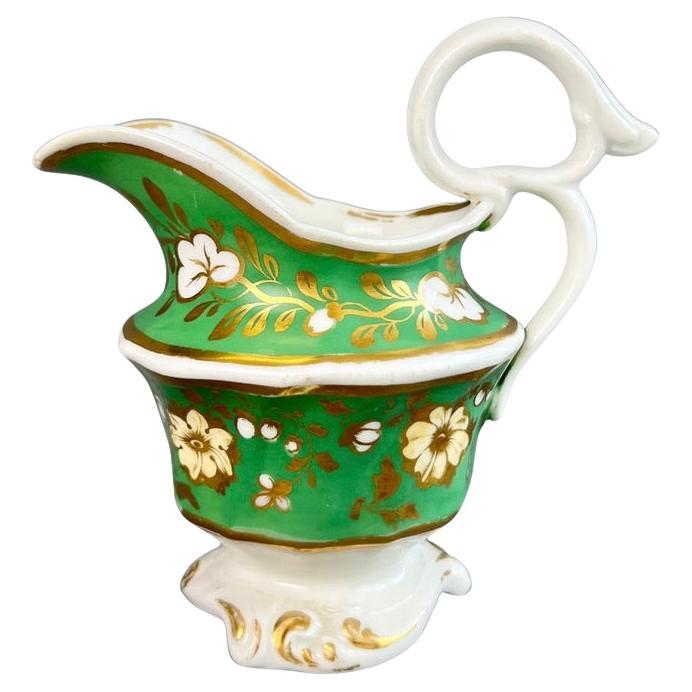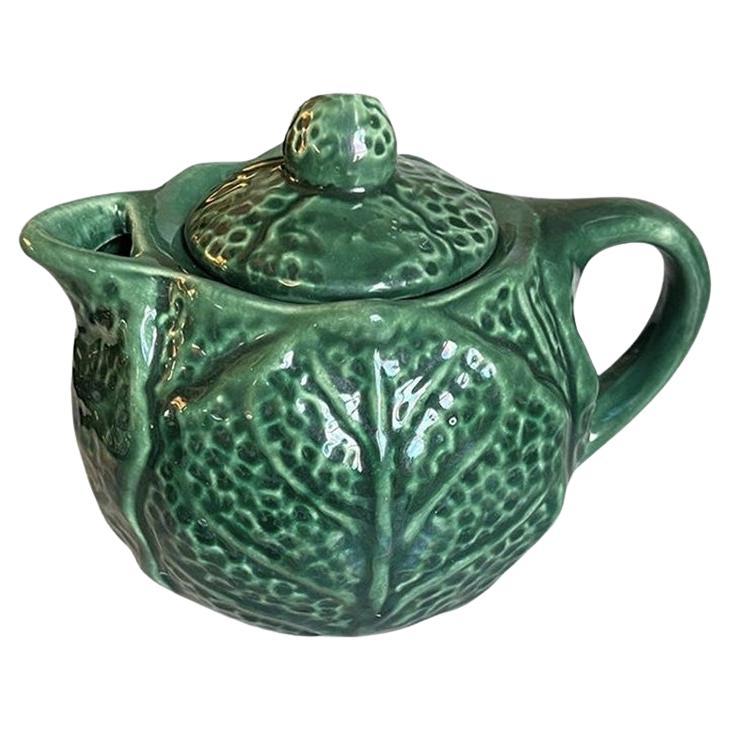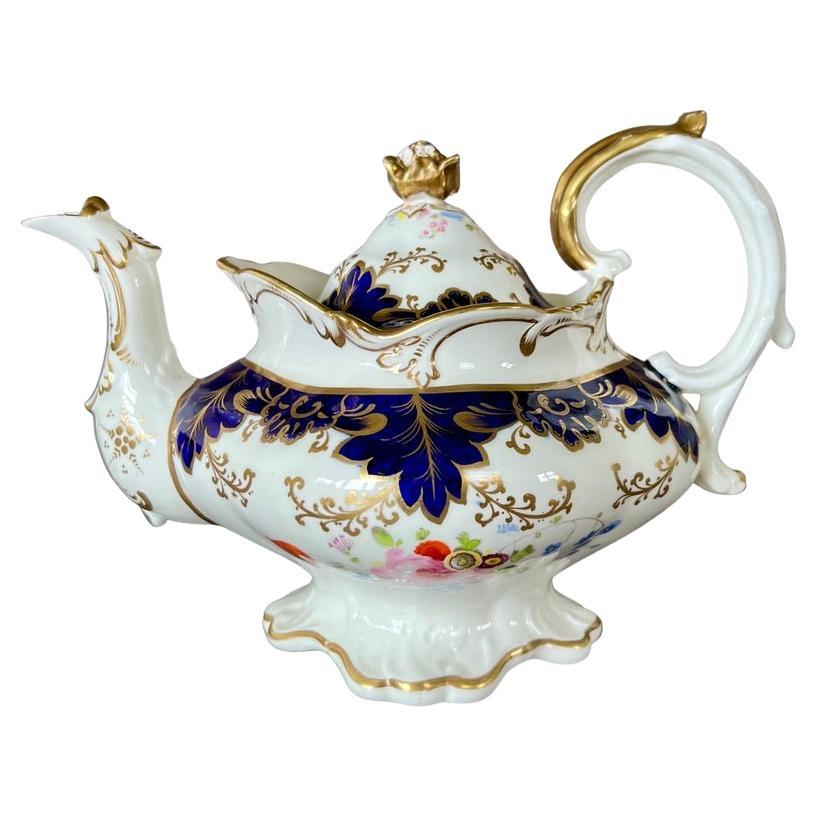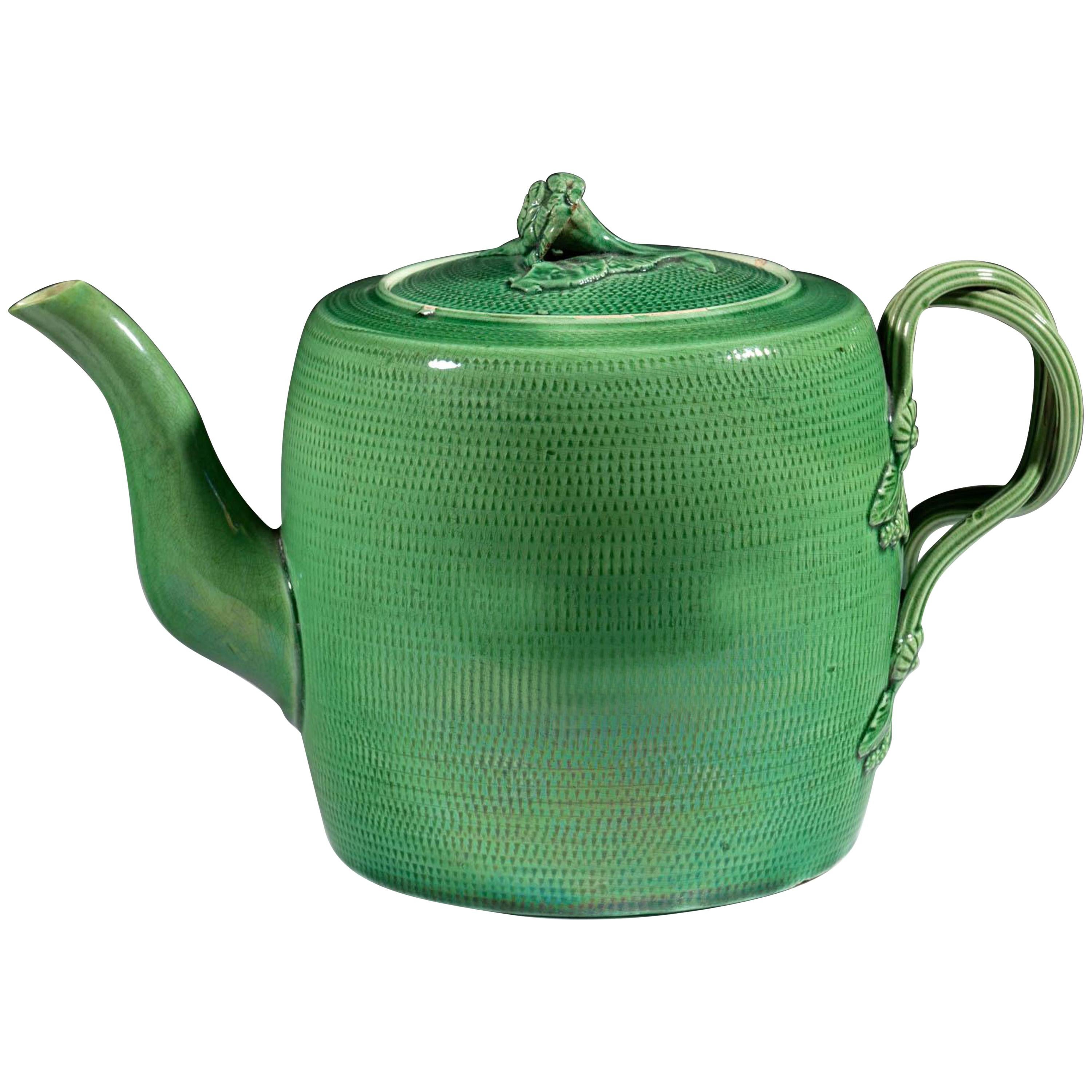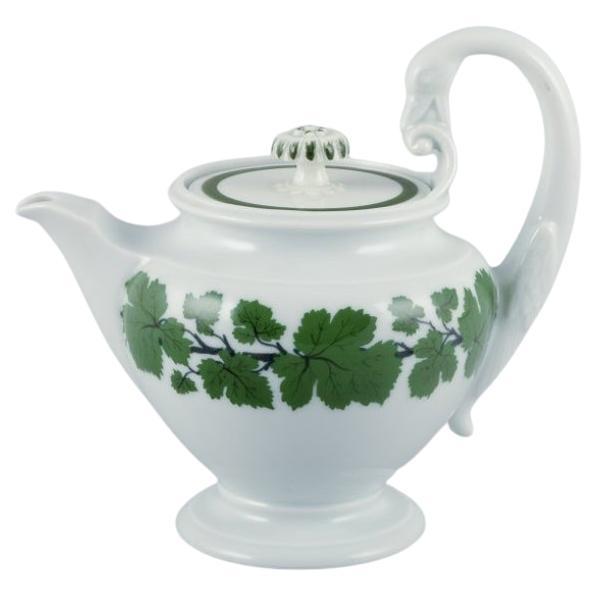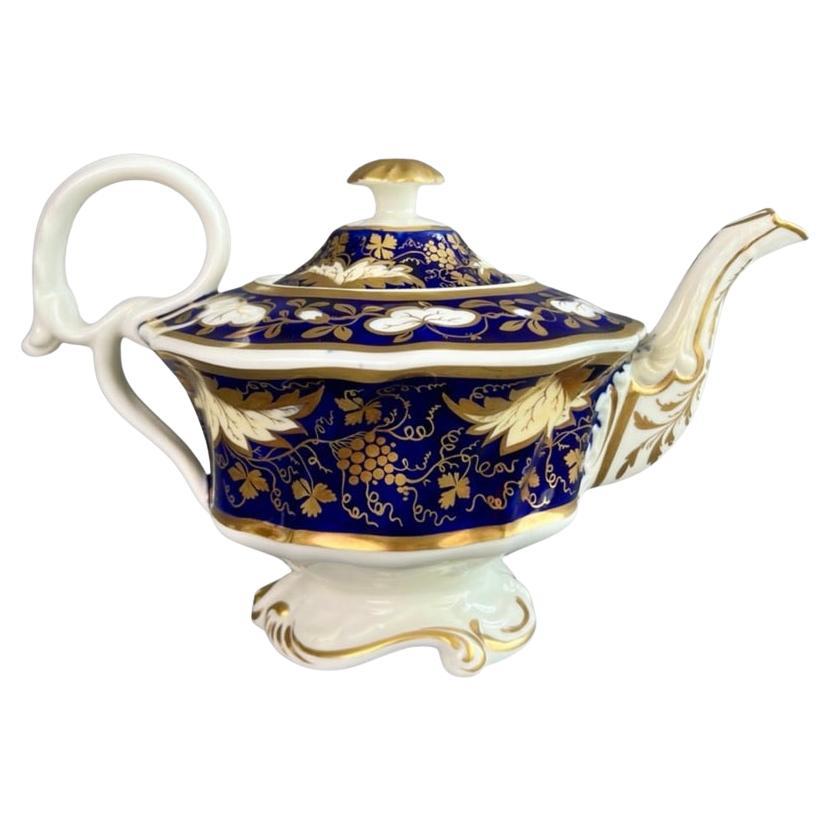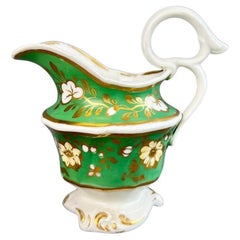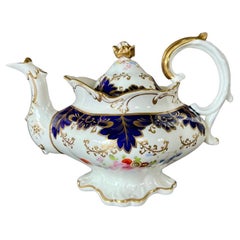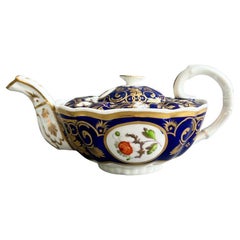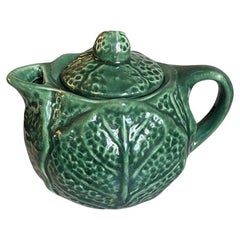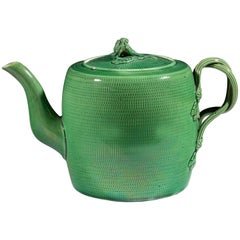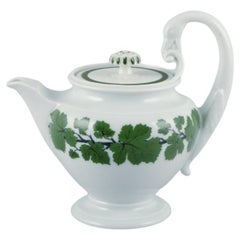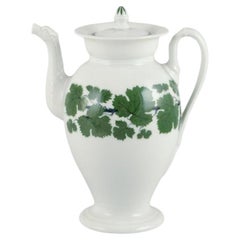Items Similar to Samuel Alcock Teapot, Emerald Green "Writhen" Shape, ca 1826
Want more images or videos?
Request additional images or videos from the seller
1 of 16
Samuel Alcock Teapot, Emerald Green "Writhen" Shape, ca 1826
$495per set
£373.80per set
€427.97per set
CA$699.07per set
A$763.22per set
CHF 400.12per set
MX$9,269.56per set
NOK 4,996.89per set
SEK 4,718.39per set
DKK 3,194.35per set
About the Item
A teapot with cover in the “writhen” shape, emerald green ground with white and pale yellow trailing florals.
We have a milk jug in a nearly identical pattern available, please see separate listing.
Pattern 2310
Year: ca 1826
Size: 28cm (10.25”) from handle to spout
Condition: perfect
The Samuel Alcock factory was operative in Staffordshire between 1822 and 1856, after which it was bought by Sir James Duke and Nephews. The factory started as a partnership between the young Samuel Alcock and the older Ralph Stevenson, who provided the factory and capital. Alcock quickly took the factory to great heights, building one of the biggest factories of its time. Alcock jumped on the new Rococo Revival fashion and served a huge new middle class market. The reason we now don't hear much about Samuel Alcock porcelain is that much of it has been mis-identified over the years and attributed to Coalport, Ridgway, Rockingham or others; Alcock did not mark any of his porcelain save a few rare pieces, and the numbering system is difficult to understand. However, the wares are still wide spread and many are of great quality.
This item forms part of the Murray Pollinger Collection of Samuel Alcock Porcelain. Most of the collection is not publicly available yet, but if you would like to get access to the first 100 lots, please sign up for our mailing list at the bottom of this page, and we will send you the full catalogue with more information, from which you can purchase more items.
Murray Pollinger was a passionate collector of Samuel Alcock porcelain. He was known as a true gentleman, impeccably dressed, always kind and modest - even some of his porcelain collecting friends had no idea about the size and importance of his collection. From the mid 1980s until shortly before his death in 2022 he collected many thousands of pieces and painstakingly catalogued them. He also went on trips to Staffordshire to discover the history of Samuel Alcock from whatever little documentation has been preserved. Through his painstaking work, Pollinger was able to make sense of the pattern numbering system that was used, and this was a huge step forward in identifying and understanding the porcelain. A website with the results of his research will be made availabe over the course of 2023. While he sold off about half of his collection in 2016, the remaining half is now made available to a new generation of collectors.
Antique British porcelain is never perfect. Kilns were fired on coal in the 1800s, and this meant that china from that period can have some firing specks from flying particles. British makers were also known for their experimentation, and sometimes this resulted in technically imperfect results. Due to the shrinkage in the kiln, items can have small firing lines or develop crazing over time, which should not be seen as damage but as an imperfection of the maker's recipes, probably unknown at the time of making. Items have often been used for many years and can have normal signs of wear, and gilt can have signs of slight disintegration even if never handled. I will reflect any damage, repairs, obvious stress marks, crazing or heavy wear in the item description but some minor scratches, nicks, stains and gilt disintegration can be normal for vintage items and need to be taken into account.
There is widespread confusion on the internet about the difference between chips and nicks, or hairlines and cracks. I will reflect any damage as truthfully as I can, i.e. a nick is a tiny bit of damage smaller than 1mm and a chip is something you can easily see with the eye; a glazing line is a break in the glazing only; hairline is extremely tight and/or superficial and not picked up by the finger; and a crack is obvious both to the eye and the finger. Etcetera - I try to be as accurate as I can and please feel free to ask questions or request more detailed pictures!
- Creator:Samuel Alcock & Co. (Maker)
- Dimensions:Height: 1 in (2.54 cm)Diameter: 1 in (2.54 cm)
- Sold As:Set of 2
- Style:Rococo Revival (Of the Period)
- Materials and Techniques:
- Place of Origin:
- Period:
- Date of Manufacture:circa 1826
- Condition:Wear consistent with age and use. perfect antique condition.
- Seller Location:London, GB
- Reference Number:Seller: MP-ALC66a1stDibs: LU4805146136852
About the Seller
5.0
Vetted Professional Seller
Every seller passes strict standards for authenticity and reliability
Established in 2016
1stDibs seller since 2019
227 sales on 1stDibs
Typical response time: 1 hour
- ShippingRetrieving quote...Shipping from: London, United Kingdom
- Return Policy
Authenticity Guarantee
In the unlikely event there’s an issue with an item’s authenticity, contact us within 1 year for a full refund. DetailsMoney-Back Guarantee
If your item is not as described, is damaged in transit, or does not arrive, contact us within 7 days for a full refund. Details24-Hour Cancellation
You have a 24-hour grace period in which to reconsider your purchase, with no questions asked.Vetted Professional Sellers
Our world-class sellers must adhere to strict standards for service and quality, maintaining the integrity of our listings.Price-Match Guarantee
If you find that a seller listed the same item for a lower price elsewhere, we’ll match it.Trusted Global Delivery
Our best-in-class carrier network provides specialized shipping options worldwide, including custom delivery.More From This Seller
View AllSamuel Alcock Milk Jug Creamer, Emerald Green "Writhen" Shape, ca 1826
By Samuel Alcock & Co.
Located in London, GB
A milk jug or creamer in the “writhen” shape, emerald green ground with white and pale yellow trailing florals.
We have a milk jug in a nearly identical pattern available, please se...
Category
Antique 1820s English Rococo Revival Porcelain
Materials
Porcelain
Samuel Alcock Porcelain Teapot, Blue, Gilt and Flowers, Rococo Revival ca 1837
By Samuel Alcock & Co.
Located in London, GB
A teapot with cover in the “rustic bean” shape, cobalt blue ground with gilt acanthus motif and finely painted flower posies on the belly of the teapot
Pattern 5782
Year: ca 1837
Si...
Category
Antique 1830s English Rococo Revival Tea Sets
Materials
Porcelain
Samuel Alcock Teapot, Cobalt Blue with Gilt Vines, "Writhen" Shape, ca 1826
By Samuel Alcock & Co.
Located in London, GB
A teapot with cover in the “writhen” shape, cobalt blue ground with white and pale yellow trailing acanthus leaves and vines.
We have a milk jug in the same pattern available, pleas...
Category
Antique 1820s English Rococo Revival Porcelain
Materials
Porcelain
Samuel Alcock Teapot, Cobalt Blue, Gilt Vines and Flowers, ca 1825
By Samuel Alcock & Co.
Located in London, GB
A beautiful teapot with cover in the "half orange" shape with “melted snow” border, decorated with a deep cobalt blue ground, rich gilt vines and hand painted flower reserves.
We al...
Category
Antique 1820s English Rococo Revival Porcelain
Materials
Porcelain
Samuel Alcock Potpourri Vase, Green, Double Cover, Landscape, Flowers, ca 1835
By Samuel Alcock & Co.
Located in London, GB
A potpourri vase with double cover, pale yellow/beige ground with apple green details, Rococo shape with fruit finial and scroll handles and foot; a flower reserve on one side and a ...
Category
Antique 1830s English Rococo Revival Vases
Materials
Porcelain
$860 / set
Free Shipping
Samuel Alcock Sucrier, French Blue, Pear Shaped Rococo Revival, 1843
By Samuel Alcock & Co.
Located in London, GB
A pear-shaped Rococo Revival sucrier with cover, with a capricious design of French blue scrolls, peach and gilt wave cartouches, and beautifully hand painted flower sprays around th...
Category
Antique 1840s English Rococo Revival Porcelain
Materials
Porcelain
You May Also Like
Green Majolica Ceramic Cabbage Leaf Teapot - Mid 20th Century
Located in Oklahoma City, OK
A small mid-century majolica teapot with a green cabbage leaf motif. This beautiful piece will be a great addition to a tea set. The body is round and features textured cabbage leave...
Category
Mid-20th Century American Hollywood Regency Pitchers
Materials
Ceramic, Paint
$56 Sale Price
20% Off
English Creamware Pottery Green Glazed Teapot and Cover, Swinton, Yorkshire
Located in Downingtown, PA
English creamware pottery green glazed teapot and cover,
Swinton, Yorkshire,
circa 1770
The barrel-form creamware teapot is decorated with a dipped green glaze over an impr...
Category
Antique 1770s English Georgian Pottery
Materials
Pottery
Meissen, Germany, Green Ivy Vine, teapot with swan-shaped handle.
Located in København, Copenhagen
Meissen, Germany, Green Ivy Vine, teapot with swan-shaped handle.
Hand-painted.
Approximately 1930.
Marked.
First factory quality.
In perfect condition. App...
Category
Vintage 1930s German Porcelain
Materials
Porcelain
$352 Sale Price
20% Off
Meissen Green Ivy Vine, coffee pot in porcelain. Approx. 1930s.
Located in København, Copenhagen
Meissen Green Ivy Vine, coffee pot.
Approximately from the 1930s.
Marked.
In excellent condition.
Third factory quality.
Dimensions: H 17.5 cm x D 14...
Category
Vintage 1930s German Porcelain
Materials
Porcelain
$352 Sale Price
20% Off
18th-century Meissen Miniature Turquoise-Ground Botanical Teapot and Cover
By Meissen Porcelain
Located in Downingtown, PA
Meissen miniature Turquoise-ground teapot and cover,
1735-40
The Meissen porcelain miniature teapot has a turquoise ground with a shaped cartouche ...
Category
Antique 1730s German Georgian Porcelain
Materials
Porcelain
Sevres Teapot, Thomas Martin Randall Decoration, circa 1835
By Manufacture Nationale de Sèvres, Thomas Martin Randall
Located in Melbourne, Victoria
A teapot from early Sevres production (around 1780), obtained as a blank, and decorated in Thomas Martin Randall's workshop in the Sevres style. I addition to his skill in painting, ...
Category
Antique Mid-19th Century English Rococo Porcelain
Materials
Porcelain
More Ways To Browse
Hand Painted Teapot
Emerald Collection Made In China
Green Teapot
Rococo Teapot
Antique Green Teapot
Meissen Sugar
Noritake Antique
Plates Marie Antoinette
Porcelain Chocolate Pots
Porcelain Ludwigsburg
Porcelain Menu
Porcelain Weave Basket
Ridgway Staffordshire
Rosenthal Angel
Rosenthal China Germany
Rosenthal Coffee Pot
Rosenthal Flute
Rosenthal Germany Coffee Pot
